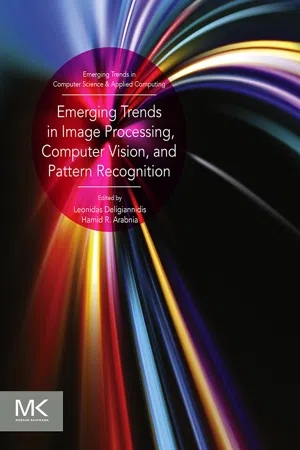
Emerging Trends in Image Processing, Computer Vision and Pattern Recognition
- 640 pages
- English
- ePUB (mobile friendly)
- Available on iOS & Android
Emerging Trends in Image Processing, Computer Vision and Pattern Recognition
About This Book
Emerging Trends in Image Processing, Computer Vision, and Pattern Recognition discusses the latest in trends in imaging science which at its core consists of three intertwined computer science fields, namely: Image Processing, Computer Vision, and Pattern Recognition. There is significant renewed interest in each of these three fields fueled by Big Data and Data Analytic initiatives including but not limited to; applications as diverse as computational biology, biometrics, biomedical imaging, robotics, security, and knowledge engineering. These three core topics discussed here provide a solid introduction to image processing along with low-level processing techniques, computer vision fundamentals along with examples of applied applications and pattern recognition algorithms and methodologies that will be of value to the image processing and computer vision research communities.
Drawing upon the knowledge of recognized experts with years of practical experience and discussing new and novel applications Editors' Leonidas Deligiannidis and Hamid Arabnia cover;
- Many perspectives of image processing spanning from fundamental mathematical theory and sampling, to image representation and reconstruction, filtering in spatial and frequency domain, geometrical transformations, and image restoration and segmentation
- Key application techniques in computer vision some of which are camera networks and vision, image feature extraction, face and gesture recognition and biometric authentication
- Pattern recognition algorithms including but not limited to; Supervised and unsupervised classification algorithms, Ensemble learning algorithms, and parsing algorithms.
- How to use image processing and visualization to analyze big data.
- Discusses novel applications that can benefit from image processing, computer vision and pattern recognition such as computational biology, biometrics, biomedical imaging, robotics, security, and knowledge engineering.
- Covers key application techniques in computer vision from fundamentals to mid to high level processing some of which are camera networks and vision, image feature extraction, face and gesture recognition and biometric authentication.
- Presents a number of pattern recognition algorithms and methodologies including but not limited to; supervised and unsupervised classification algorithms, Ensemble learning algorithms, and parsing algorithms.
- Explains how to use image processing and visualization to analyze big data.
Frequently asked questions
Information
Denoising camera data
Shape-adaptive noise reduction for color filter array image data
2 Technische Universität München, München, Germany
Abstract
1 Introduction
Table of contents
- Cover image
- Title page
- Table of Contents
- Copyright
- Contributors
- Acknowledgments
- Preface
- Introduction
- Part 1: Image and Signal Processing
- Part 2: Computer Vision and Recognition Systems
- Part 3: Registration, Matching, and Pattern Recognition
- Index